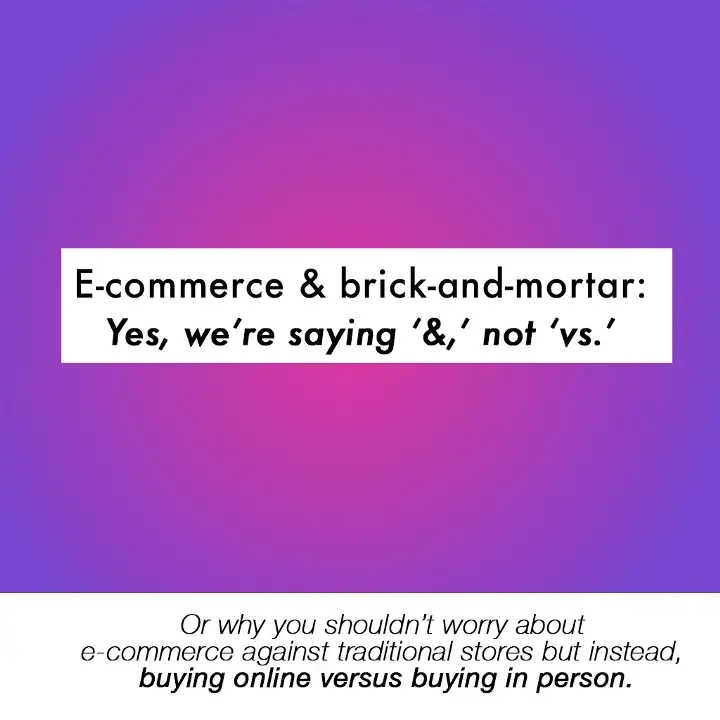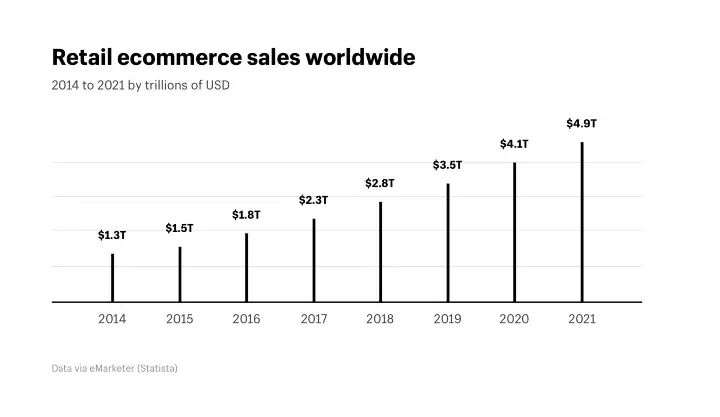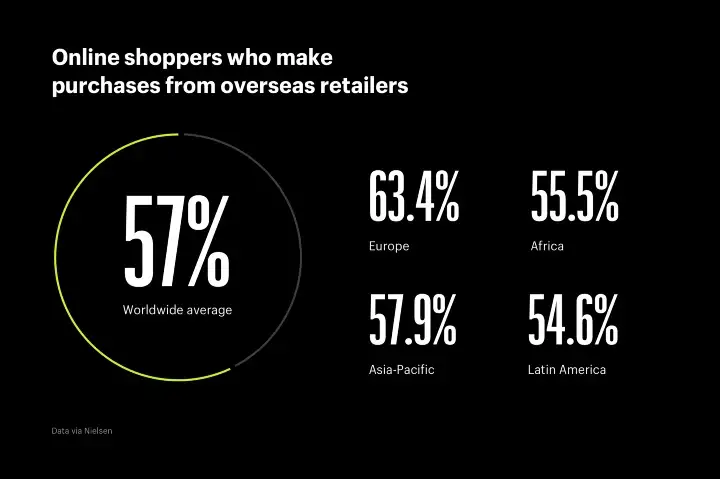E-commerce & brick-and-mortar: Yes, we’re saying ‘&,’ not ‘vs.’

Let’s start by defining what e-commerce is.
E-commerce: activities that relate to the buying and selling of goods and services over the Internet. (Merriam-Webster)
According to Shopify, E-commerce has existed since 1994, when a man sold a CD to his friend through his website NetMarket, an American retail platform.
Not long after this, Amazon and eBay came to play and started a trend that has no end in sight. In fact, e-commerce just keeps growing and growing, and so does its sales.

Just like we see in traditional distribution channels, there are 4 main e-commerce models:
- Business to Business (B2B)
- Business to Consumer (B2C)
- Consumer to Consumer (C2C)
- Consumer to Business (C2B)
But this is a very simplified way of identifying e-commerce players. Nowadays, you can focus on retail, drop shipping, wholesale distribution, crowdfunding, and subscriptions, and you can sell not only physical products but also digital products and services.
E-commerce is a whole new world, and whether you like it or not, it’s here to stay and it’s just going to keep growing. Once you acknowledge this fact, you need to decide if you want to use it as a tool to grow your business or you want to ignore it.
Yes, e-commerce can be used as a tool for your business, just like the internet, email marketing, traditional advertising, deliveries, promotions, stores, etc. These tools are up for grabs to everyone who wants to find new ways to grow their companies. Whether you personally like them or not, someone out there is using them for their own benefit.
The biggest neglecters of e-commerce are the same people who have high praise for it: retailers. If you own a brick-and-mortar store, you might feel that e-commerce is your biggest competitor, but in reality, it could be your biggest ally. Despite what a lot of people think, the rivalry is not e-commerce versus traditional stores, but buying online versus buying in person.
They’re two different channels with two different audiences. When you choose to be oblivious to one or the other, you’re choosing to ignore a large market of potential clients.
Don’t get me wrong, every industry, every company, and every product has its own challenges when it comes to e-commerce, but both e-commerce and traditional stores can be used for multiple purposes, not just for selling. Communicating your brand, showcasing and promoting your products, connecting with your audience, and providing customer and post-sale services are all actions that consumers are expecting from you when they walk into your store or visit your website.
For today’s consumer, your e-commerce needs to deliver just as unique of an experience as your store does, where buying is as easy, satisfying, and fun as it can get.
Stores are not dying, their purposes are merely shifting. They’re becoming more of a showroom, a customer service point, and a go-to place for those looking for a tailored, personalized experience.

As always, a lot of people will walk out of your store without buying anything, but that’s where e-commerce becomes so useful. Some people conduct their purchases entirely online, while others enjoy going to stores to touch the product and take it home on the spot, without having to wait for it to be shipped to them. But the majority of consumers fall somewhere in the middle of the spectrum. You’ll see some consumers go to stores to buy what they saw online, on Instagram, or even in advertisements. You’ll see others go to the store, test out the product to make sure that they want it, and then finalize the transaction online. And these audiences are exactly what you’re missing if you’re avoiding e-commerce entirely. E-commerce allows you to sell your products to more people at a smaller cost. Picture it as a new store that you just opened, but where you don’t have to pay employees or rent, and that you can keep open 24/7, everywhere in the world (if you want to).

Customers can behave in so many different ways, not just A or B, and most of us fall in the middle. To deliver an efficient solution, many companies approach the problem using an omnichannel distribution strategy. PipeCandy estimates that there are between 2 million and 3 million e-commerce companies in the world (excluding China). North America alone has about 1.3 million e-commerce companies. Even if you exclude marketplaces sellers, such as Amazon, Etsy, eBay, etc., there would still be somewhere around 250,000 to 300,000 e-commerce companies in the U.S.
On the other hand, there are fewer than 100,000 pure e-commerce companies around the world, meaning that when it comes to e-commerce, omnichannel is the rule and ‘pure-play’ e-commerce is the exception.
Keep in mind that there’s bigger competition and that there are still costs to consider. However, when executed well, e-commerce is an ally that helps small, medium, and large companies alike, and if you rush me, I’d even say that small and medium companies are the ones that get the biggest benefit from it. Again, when done right, complemented with effective SEO and paid advertising strategies, a conversion-friendly website, a strong presence on social media, and powerful branding (all done in a device-friendly manner), your company can be just as visible to the consumer as giant competitors.
As I said before, e-commerce is not your enemy. I understand that a lot of traditional store owners find themselves hesitant because of the history and memories that may come with their brick-and-mortar. All emotions aside, you need to see e-commerce as a tool that you can leverage to help your store survive bad periods or even find new reasons to exist. The sooner you realize it, the more time you’ll have to make your company visible in the digital world — which is a big part of the real world, in case you haven’t noticed yet. It breaks my heart to see family-owned stores that shut down because they didn’t know how to reshape their business or use these digital instruments in their favor.
If you don’t believe me, look at what some of the biggest brands are doing:
- Apple is looking to have around 600 stores by 2023, employing up to 80,000 customer service specialists.
- At the end of 2018, Nike opened a 68,000-square-foot megastore in NYC.
- Amazon purchased Whole Foods and used the two different business models to complement each other.
Again, for the people in the back, e-commerce is not your enemy. You need to think about this as two different markets that you can tap: people who buy online and people who buy in person.
We all know the golden rule for brick-and-mortar stores: location, location, location. That same principle applies to today’s world, but your audience is no longer found on a particular street or in a specific neighborhood — they’re on the internet. Location is still key, and more than ever, you need to be where your customers are. A digital strategy will give you the insights and consumer information that you need to make your store experience more complete. Innovation is just as important in your store as it is for your online experience.
Just as you invest in making your store look pretty and be able to deliver a satisfying customer experience, you have to do the same for your website. And most consumers will begin, finish, or cruise by your digital presence during their purchasing journey. Pure-channel customer journeys no longer exist, if they ever did. It’s up to you to create an all-encompassing customer experience where both channels work together to close sales, keep your audience engaged, and deliver a memorable, pleasant experience — even if the client doesn’t finish the purchase at the time.
Face-to-face interaction, sensory experiences, and geographic location are the unique values of your physical store, and those are still some of the most efficient tools that you can use to create real, authentic, long-term relationships with your customer.
Since most of us participate in hundreds of social connections and are exposed to thousands of ads, in-person, real experiences matter more than ever. Traditional stores are still here and will be here for a while. Don’t ask what your customer can do for your store, ask what your store can do for your customer — even if the answer isn’t selling.
What do you think about the role of e-commerce? Do you have any questions for me? Let’s chat!
justo@sofiadigital.agency

